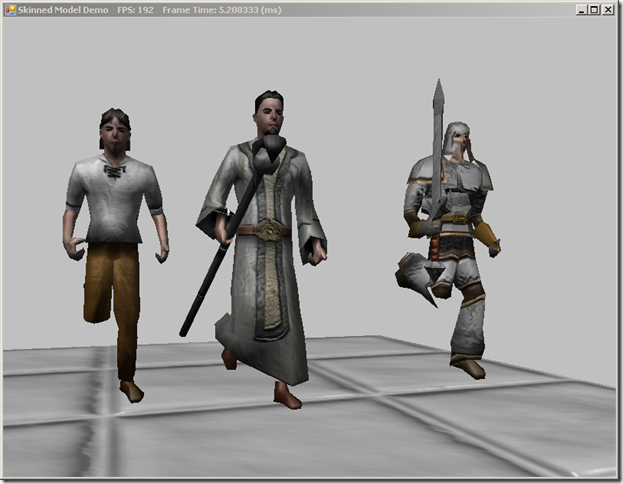Sorry for the hiatus, I’ve been very busy with work and life the last couple weeks. Today, we’re going to look at loading meshes with skeletal animations in DirectX 11, using SlimDX and Assimp.Net in C#. This will probably be our most complicated example yet, so bear with me. This example is inspired by Chapter 25 of Frank Luna’s Introduction to 3D Game Programming with Direct3D 11.0 , although with some heavy modifications. Mr. Luna’s code uses a custom animation format, which I found less than totally useful; realistically, we would want to be able to load skinned meshes exported in one of the commonly used 3D modeling formats. To facilitate this, we will again use the .NET port of the Assimp library, Assimp.Net. The code I am using to load and interpret the animation and bone data is heavily based on Scott Lee’s Animation Importer code, ported to C#. The full source for this example can be found on my GitHub repository, at https://github.com/ericrrichards/dx11.git under the SkinnedModels project. The meshes used in the example are taken from the example code for Carl Granberg’s Programming an RTS Game with Direct3D .
Skeletal animation is the standard way to animate 3D character models. Generally, a character model will be represented by two structures: the exterior vertex mesh, or skin, and a tree of control points specifying the joints or bones that make up the skeleton of the mesh. Each vertex in the skin is associated with one or more bones, along with a weight that determines how much influence the bone should have on the final position of the skin vertex. Each bone is represented by a transformation matrix specifying the translation, rotation and scale that determines the final position of the bone. The bones are defined in a hierarchy, so that each bone’s transformation is specified relative to its parent bone. Thus, given a standard bipedal skeleton, if we rotate the upper arm bone of the model, this rotation will propagate to the lower arm and hand bones of the model, analogously to how our actual joints and bones work.
Animations are defined by a series of keyframes, each of which specifies the transformation of each bone in the skeleton at a given time. To get the appropriate transformation at a given time t, we linearly interpolate between the two closest keyframes. Because of this, we will typically store the bone transformations in a decomposed form, specifying the translation, scale and rotation components separately, building the transformation matrix at a given time from the interpolated components. A skinned model may contain many different animation sets; for instance, we’ll commonly have a walk animation, and attack animation, an idle animation, and a death animation.
The process of loading an animated mesh can be summarized as follows:
- Extract the bone hierarchy of the model skeleton.
- Extract the animations from the model, along with all bone keyframes for each animation.
- Extract the skin vertex data, along with the vertex bone indices and weights.
- Extract the model materials and textures.
To draw the skinned model, we need to advance the animation to the correct frame, then pass the bone transforms to our vertex shader, where we will use the vertex indices and weights to transform the vertex position to the proper location.

